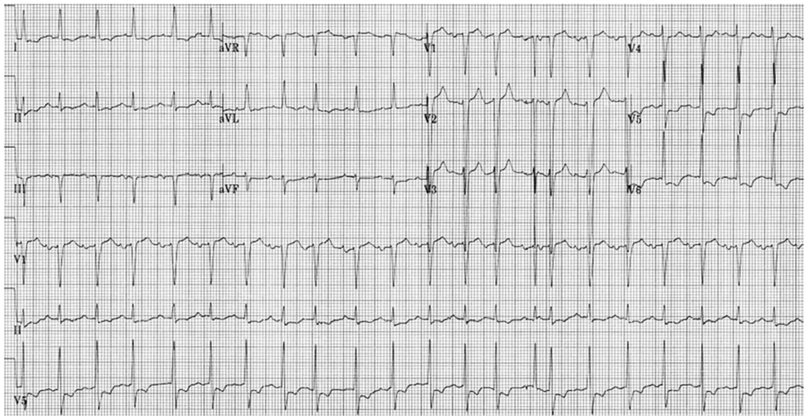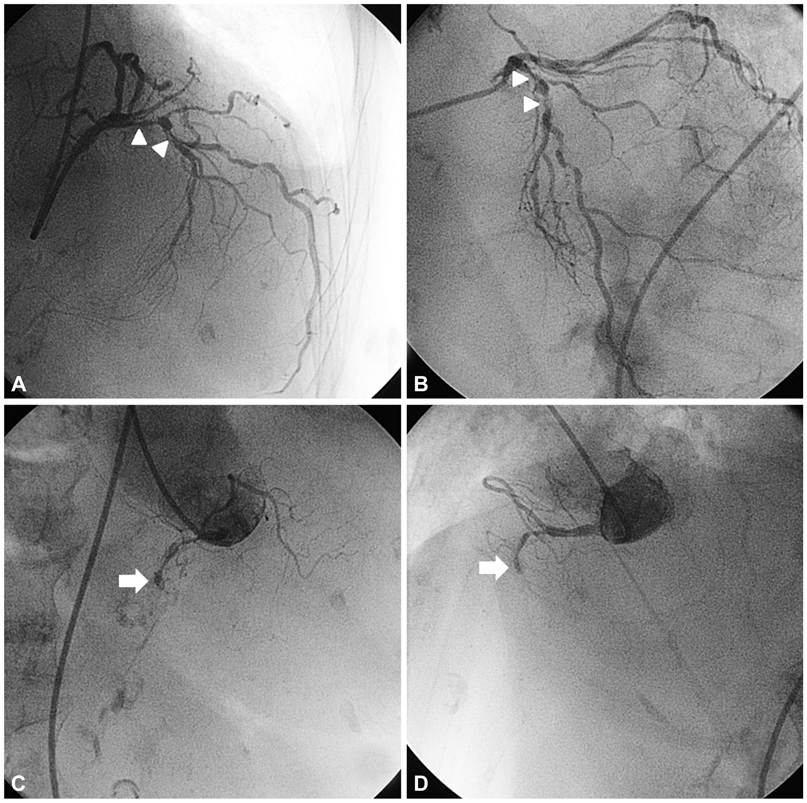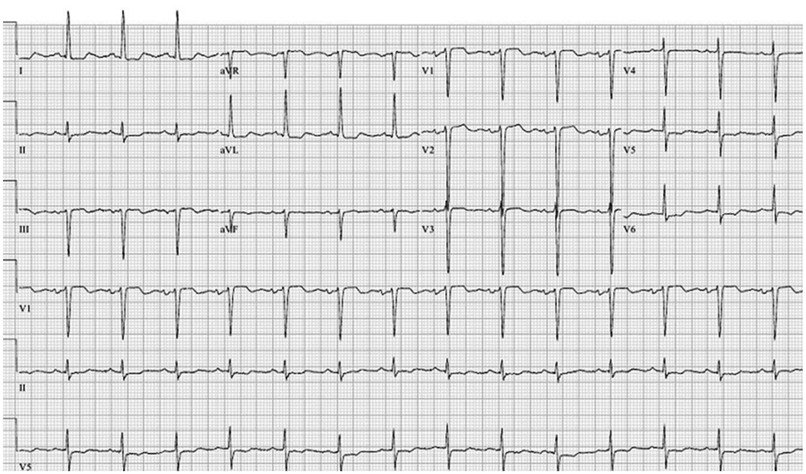Korean Circ J.
2012 May;42(5):355-359. 10.4070/kcj.2012.42.5.355.
Successful Percutaneous Coronary Intervention in a Centenarian Patient With Acute Myocardial Infarction
- Affiliations
-
- 1The Heart Research Center of Chonnam National University Hospital, Cardiovascular Research Institute of Chonnam National University, Gwangju, Korea. myungho@chollian.net
- KMID: 2028767
- DOI: http://doi.org/10.4070/kcj.2012.42.5.355
Abstract
- Despite an increasing prevalence and burden of disease in the elderly, little is known about the management and outcomes of acute coronary syndromes in this group. We report the case of a 101-year-old female patient with a non-ST segment elevation myocardial infarction. Coronary angiography showed a total occlusion of the proximal right coronary artery (RCA), and a significant stenosis in the proximal to mid left anterior descending artery (LAD). Despite a very poor initial clinical status, a percutaneous coronary intervention was successfully performed for the total occlusion in the RCA. The LAD lesion was treated with medical therapy only, on account of the age and general condition of the patient. She was discharged after recovering to a good health status, free of chest pain or dyspnea.
MeSH Terms
Figure
Reference
-
1. Avezum A, Makdisse M, Spencer F, et al. Impact of age on management and outcome of acute coronary syndrome: observations from the Global Registry of Acute Coronary Events (GRACE). Am Heart J. 2005. 149:67–73.2. Skolnick AH, Alexander KP, Chen AY, et al. Characteristics, management, and outcomes of 5,557 patients age > or =90 years with acute coronary syndromes: results from the CRUSADE Initiative. J Am Coll Cardiol. 2007. 49:1790–1797.3. From AM, Rihal CS, Lennon RJ, Holmes DR Jr, Prasad A. Temporal trends and improved outcomes of percutaneous coronary revascularization in nonagenarians. JACC Cardiovasc Interv. 2008. 1:692–698.4. Batchelor WB, Anstrom KJ, Muhlbaier LH, et al. Contemporary outcome trends in the elderly undergoing percutaneous coronary interventions: results in 7,472 octogenarians: National Cardiovascular Network Collaboration. J Am Coll Cardiol. 2000. 36:723–730.5. Floyd KC, Jayne JE, Kaplan AV, et al. Age-based differences of percutaneous coronary intervention in the drug-eluting stent era. J Interv Cardiol. 2006. 19:381–387.6. Klein LW, Block P, Brindis RG, et al. Percutaneous coronary interventions in octogenarians in the American College of Cardiology-National Cardiovascular Data Registry: development of a nomogram predictive of in-hospital mortality. J Am Coll Cardiol. 2002. 40:394–402.7. Cohen HA, Williams DO, Holmes DR, et al. Impact of age on procedural and 1-year outcome in percutaneous transluminal coronary angioplasty: a report from the NHLBI Dynamic Registry. Am Heart J. 2003. 146:513–519.8. Galioto A, Dominguez LJ, Pineo A, et al. Cardiovascular risk factors in centenarians. Exp Gerontol. 2008. 43:106–113.9. Singh M, Rihal CS, Lennon RJ, Garratt KN, Mathew V, Holmes DR Jr. Prediction of complications following nonemergency percutaneous coronary interventions. Am J Cardiol. 2005. 96:907–912.10. Lee SH, Chae JK. Long-term clinical outcomes of percutaneous coronary intervention using drug-eluting stents in octogenarians and older. Korean Circ J. 2007. 37:647–655.11. Chung WS, Kim CJ, Seung KB, et al. Characteristics of coronary artery stenting in the elderly over 70 years old: short-term outcome and long-term angiographic and clinical follow-up. Korean Circ J. 2001. 31:996–1003.12. Lim SY, Jeong MH, Yang BR, et al. Long-term clinical outcomes after primary percutaneous coronary intervention in patients with acute myocardial infarction older than 75 years. Korean Circ J. 2005. 35:613–619.13. Singh M, Rihal CS, Gersh BJ, et al. Twenty-five-year trends in in-hospital and long-term outcome after percutaneous coronary intervention: a single-institution experience. Circulation. 2007. 115:2835–2841.
- Full Text Links
- Actions
-
Cited
- CITED
-
- Close
- Share
- Similar articles
-
- No-Reflow Phoenomenon by Intracoronary Thrombus in Acute Myocardial Infarction
- Cardiac arrest due to an unexpected acute myocardial infarction during head and neck surgery: A case report
- Successful Primary Percutaneous Coronary Intervention without Stenting: Insight from Optimal Coherence Tomography
- Anomalous Origin of the Left Coronary Artery from the Right Sinus of Valsalva, which Presented as Acute Myocardial Infarction
- Successful Percutaneous Coronary Intervention in a Young Male Systemic Lupus Erythematosus Patient with Acute Myocardial Infarction





